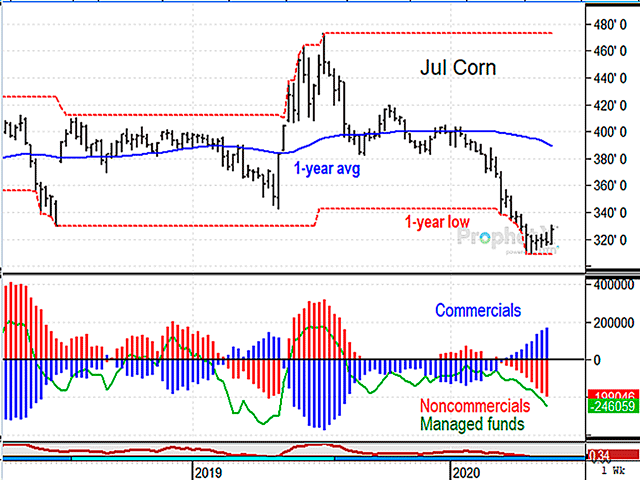Todd's Take
A Bullish Change in Corn
As I started the workday early Thursday (May 28), I fully expected to be writing bearish market comments about how soybean prices were dragged lower by the escalating tensions between the U.S. and China, related to Hong Kong. Overnight, China's Congress passed the new security law by a near unanimous vote, designed to suppress dissent in Hong Kong.
China's move is a violation of the treaty it signed with Britain in 1984, in which it promised to maintain civil liberties in Hong Kong until 2047. The U.S., Britain, Canada and Australia have all objected to China's latest move and President Donald Trump is expected to announce some form of retaliation Friday.
I expected to be writing about China for Friday morning's column, but the corn market had other plans -- too interesting to ignore and strong enough to distract soybean traders from China's news for a day. July soybeans ended down just 1 1/2 cents.
July corn prices, beat down in 2020 by arguably the most bearish cluster of demand factors in at least 50 years, finally showed enough gumption to break out of its 13 1/4 cent trading range to a new one-month high Thursday, settling 7 cents higher at $3.27 1/2.
Granted, that is still a long way from the glorious peak of $4.72 3/4 reached last July, but for a market beat down by coronavirus-related issues and the prospects of a 16 billion bushel (bb) corn crop this fall, Thursday's higher close was significant for several reasons.
P[L1] D[0x0] M[300x250] OOP[F] ADUNIT[] T[]
We have been seeing gradual signs of increasing corn demand for several weeks. Thursday's report from the Energy Department was the latest, showing last week's ethanol production increased from 663,000 to 724,000 barrels per day. Compared to a year ago, 724,000 barrels a day represents a loss of 145 million bushels (mb) of corn demand per month, but that is better than the roughly 180 mb lost in March and April.
Meat processing plants have also made impressive strides to increase the amount of livestock they accept. Last week's hog slaughter was down just 8% from a year ago, a big improvement from the annual slaughter deficits of more than 30% seen for cattle and hogs just a few weeks ago.
Strict fundamentalists will be quick to point out that even with the gradual improvements in demand, the U.S. is headed for ending corn stocks of 3 bb or more in 2020-21 and the point is well-taken. Thursday's 7-cent rally is not the end of corn's bearish problems, but there is room for corn to trade higher before we know more about the next crop.
The most bullish aspect of Thursday's rally is that CFTC already told us managed futures funds were holding 246,059 net short obligations as of May 19, while commercials owned 171,187 net longs. As I have explained often in this space, few know the value of corn better than commercials. The speculative side of the market, on the other hand, has a bad knack of making big bets at the wrong times.
For those that regularly buy feed corn, recognizing the widely different positions between commercials and speculators was a big part of why DTN recommended buying feed corn needs on April 27 through the end of July. DTN's National Corn Index was near $2.81 at the time and closed at $3.03 Thursday.
As it looks now, funds confident about being short corn near its lowest July prices in 13 years was not a good move. As usual, summer weather will have a lot to say about how big the 2020 corn crop will be and we can't rule out a return to corn's lower prices this fall.
For now, however, the dynamic has turned bullish as Thursday's new one-month high puts the bearish funds under pressure to liquidate. Meanwhile, we will find out if the dry seven-day forecast is the start of a drier trend to come or just the beginning of another favorable year for crop yields.
We can't yet say the larger fundamentals of corn have turned bullish, but after watching prices slide lower all year, it's about time prices rotate higher. Thursday's rally likely marked a modest beginning of that effort.
Todd Hultman can be reached at Todd.Hultman@dtn.com
Follow him on Twitter @ToddHultman
(BE/SK )
(c) Copyright 2020 DTN, LLC. All rights reserved.




